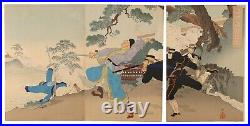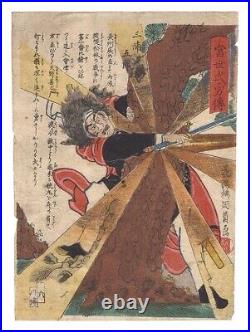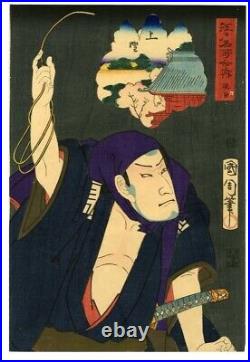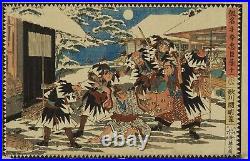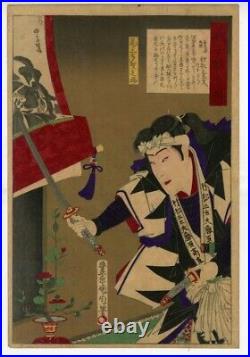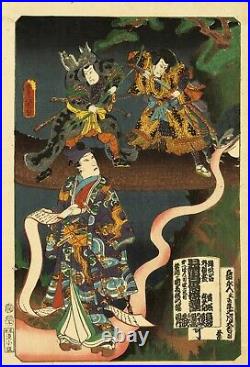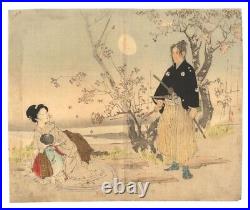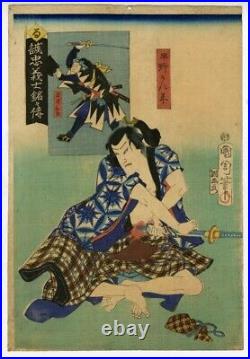Anjo Wataru Great Battle – Captain Matsuzaki’s Valor. 1894 (27th year of Meiji). Good printing, good preservation.
WB Toshikata Japan Woodblock Prints Antique Ukiyo-e War Katana Soldier Triptych
Author: adminMay 19
WB Ginko Japanese Woodblock Prints Antique Ukiyo-e War Katana Soldier Triptych
Author: adminMay 16
Artwork Battle of Kaijo. Good, trimming, a little foxing, a little soiling, edge crease (a part of it is cut off) The left and the middle panels are connected. Large size About the size of Ukiyo-e. 3 sheets in a row.
WB Toyokuni Japanese Woodblock Prints Antique Meiji Ukiyo-e Kabuki Snow Katana
Author: adminOct 23
Date : 4th year of Ansei. Detail: Binding hole / Slight soiling / Edge crease / Repair of small insect hole on the margin. Odori katagata gaitame jutsu is a series of kabuki plays depicting scenes from the past up to the time of its production. It is characterized by its vertical composition of a horizontal stage, and depicts many tall performances such as staircases and midair rides. For performances that do not feature many tall staging, the composition is as if looking down from above, as if the viewer is looking down from the audience seats. One can see the author’s determination to convey the charm of the kabuki stage itself. Toyokuni III was a student of Toyokuni, who first took the name Kunisada, and in 1882 took the name Toyokuni II. In fact, Toyokuni II had already been succeeded by Toyoshige, but Toyokuni III took the name of Toyokuni II at that time, perhaps with the intention of making himself more suitable. Today, Toyokuni is referred to as Toyokuni III for the sake of distinction. Toyokuni had a long period of painting, and it is thought that he produced more than 10,000 works. He was especially known for his depictions of people, including portraits of actors and beautiful women, and the number of his works and his vigor suggest that he dominated the Edo Ukiyoe world.
WB Kunikazu Japanese Woodblock Prints Antique Ukiyo-e Hero Katana Samurai Miura
Author: adminSep 25
Biographies of Valor in the Modern Era (VI) Goro Miura. Good, Some stains, Scratches, Some fading, Edge wear. As the work is quite old, it is scratched and soiled. Please understand that it is an antique artwork.
WB Kunichika Japanese Woodblock Prints Asian Antique Ukiyo-e Ninja Katana Sakura
Author: adminSep 11
Title Edo Meisho Gonouchi Ueno Umesuke. Date: 1867 (Keio 3). Size: 24.5 x 36 cm. His aliases include Hanacho-rou, Ichiiyinsai, and Toyoharu-rou. After studying under Shunobu Toyohara and creating the original illustrations for hagoita oshie, he was introduced to Kunisada (Toyokuni III). He produced many yakusha oshibu-e (large head paintings of actors) and demonstrated his ability. In his later years, he produced many portraits of actors in the traditional style, often depicting a half of an actor standing alone on a series of three panels. The portrayal of facial features is characteristic of the Hagoita style.
WB Kuniaki Japanese Woodblock Prints Antique Ukiyo-e Snow winter Samurai Katana
Author: adminSep 7
Pseudonym Teppon Tadatsumi Kura 11 12 Circles. 1858, 5th year of the Ansei era. Well-painted and preserved, with few stains, few scratches, and very few insect holes, and with few tears and repairs in the lower corners. Each about 23.5×36.5cm.
WB Kunichika Japanese Woodblock Prints Asian Antique Meiji Ukiyo-e Katana Bonsai
Author: adminSep 7
Title Yoshishi Meishiden Muramatsu Santayu. Condition: Stains and rubs. Size: 24 x 36 cm. His aliases include Hanacho-rou, Ichiiyinsai, and Toyoharu-rou. After studying under Shunobu Toyohara and creating the original illustrations for hagoita oshie, he was introduced to Kunisada (Toyokuni III). He produced many yakusha oshibu-e (large head paintings of actors) and demonstrated his ability. In his later years, he produced many portraits of actors in the traditional style, often depicting a half of an actor standing alone on a series of three panels. The portrayal of facial features is characteristic of the Hagoita style.
WB Toyokuni Japanese Woodblock Prints Antique Meiji Ukiyo-e Kabuki Kimono Katana
Author: adminSep 5
Date : 3rd year of Ansei. Detail: Binding hole / Slight soiling / Repair of a few foxing marks. The “Kodaraiya Gouketsu Tan” is an illustrated novel published from the 10th year of the Tempo Period. The character “Kodaraiya” was a fictional bandit and ninja who appeared in a late-Edo Period yomihon (a book read in the late Edo Period), and his activities as a magician who wields an echidna became the subject of many works as well as stories. Later, Tsunade, who wielded slugs, and his arch-enemy, Daijamaru, who wielded snakes at will, also appeared, and the story unfolded as a three-way struggle. Odori katagata gaitama jutaku is a series of kabuki plays depicting scenes from the past up to the time of their production. It is characterized by a vertical composition of a horizontal stage, and depicts many tall performances, such as staircases and midair rides. For performances that do not feature many tall staging, the composition is as if looking down from above, as if the viewer is looking down from the audience seats. One can see the author’s determination to convey the charm of the kabuki stage itself. Toyokuni III was a student of Toyokuni, who first took the name Kunisada, and in 1882 took the name Toyokuni II. In fact, Toyokuni II had already been succeeded by Toyoshige, but Toyokuni III took the name of Toyokuni II at that time, perhaps with the intention of making himself more suitable. Today, Toyokuni is treated as Toyokuni III for the sake of distinction. Toyokuni had a long period of painting, and it is thought that he produced more than 10,000 works. He was especially known for his depictions of people, including portraits of actors and beautiful women, and the number of his works and his vigor suggest that he dominated the Edo Ukiyoe world.
WB Shoso Mishima Japanese Woodblock Prints Antique Ukiyo-e Sakura Samurai Katana
Author: adminSep 4
Trimming, Slight foxing, Few stains, Minor insect holes, Attached on the reverse side, Remains of peeling. Size: 22.2 x 26.6 cm (sheet size). 22.2 x 26.6 cm (sheet size). 1896 (Meiji 29th year).
WB Kunichika Japanese Woodblock Prints Asian Antique Meiji Ukiyo-e Katana Kabuki
Author: adminSep 2
Title Sincerely yours truly, Yoshifumi Meiden HAYANO Kanpei. Date: 1866 (Keio 2). Condition: Holes, stains, rubbing. Size 25.5 x 37.5 cm. His aliases include Hanachouro, Ichiiyinsai, and Toyoshunro. After studying under Shunobu Toyohara and creating the original illustrations for hagoita oshie, he was introduced to Kunisada (Toyokuni III). He produced many yakusha oshibu-e (large head paintings of actors) and demonstrated his ability. In his later years, he produced many portraits of actors in the traditional style, often depicting a half of an actor standing alone on a series of three panels. The portrayal of facial features is characteristic of the Hagoita style.

